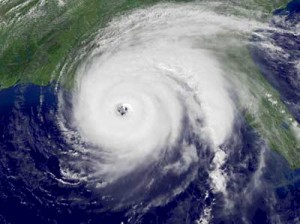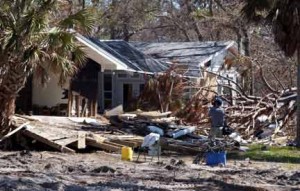by Tim George
 In September of 2004 the second worst hurricane of the decade plowed through the Cayman Islands, shot the gap between Cuba and the Yucatan, aligned itself in a trough of super-heated Gulf water, and took direct aim at the Gulf Coast. It had already been “the year of the hurricane,” with a total of five Category 2 or greater hurricanes to pass through or near Florida. Had it not been for another storm by the name of Katrina that followed a year later on a more westerly track, people in other states may remember Ivan the way most do Katrina.
In September of 2004 the second worst hurricane of the decade plowed through the Cayman Islands, shot the gap between Cuba and the Yucatan, aligned itself in a trough of super-heated Gulf water, and took direct aim at the Gulf Coast. It had already been “the year of the hurricane,” with a total of five Category 2 or greater hurricanes to pass through or near Florida. Had it not been for another storm by the name of Katrina that followed a year later on a more westerly track, people in other states may remember Ivan the way most do Katrina.
For my family, this was our first major storm since moving to the Florida Panhandle in 2000. Just as locals in other parts of the country mark the history of their lives by weather events, so do Floridians. We had heard all the stories, read up on how to prepare, gathered up as many supplies as we could find, and mapped out our battle plan.
Evacuation during a major hurricane is not as simple a decision as the uninitiated might suspect. Though tracking of storms has become quite sophisticated and accurate, the decision to leave still involves many factors: leave too early, and you find yourself sitting hundreds of miles away unable to work or be near others you care about back home; wait too long, and you might find yourself stuck with thousands of others on an interstate with no way to move forward or back. My wife and I had no children at home and our oldest son and his family were not leaving town, so we made the decision to stay.
First there was the windless, hot calm, hours before landfall. You drive down empty streets past miles of boarded up businesses, stores are closed, and for the life of you, it looks like a scene from I Am Legend as Will Smith drives along the deserted streets of New York. Then there are the long hours of nothing to do but wait. Should there ever be a shortage of meteorologists there is a deep pool of amateur talent here in Florida. We all understand barometric pressure is like a golf score; the lower it gets the more impressive. And in the case of Hurricane Ivan, the more potentially destructive. As each hour passed, the newscasters didn’t have to tell us we were in for a long night.
Like statistics in football games, the effect of a hurricane can be quite deceiving if all you look at are numbers and satellite pictures. Ivan rapidly fell from a Category 5 to a Category 3 its last few miles before landfall, and the southwestern wall of the storm all but disappeared. Unfortunately, we live in Pensacola, on the northwestern corner. Ivan hit Perdido Key with a sucker punch and then did an odd thing – it jagged to the east just a bit and decided to make a slow, lingering crawl across the area, its eye following Escambia bay. Throughout the night, after the power was gone and the last local radio station I could find was lost, my wife and I (plus our dog) huddled in our hurricane place (a large closet) and listened to what sounded for all the world like the inside of a commercial washing machine. The hurricane force winds lasted from just before midnight until the first light of dawn. Except for a huge limb from our ancient oak in the backyard that found its way through the back of our house, we had survived unscathed.
The most surreal part of a major hurricane is how little you know about what is going on around you. With no landlines, no cell service, and no local media, we had no idea how bad things really were. Understand, I have lived with tornadoes all of my life. Mississippi has its own tornado alley that has been the track of deadly storms through the last century. In March 1966, one of the strongest such storms in U.S. history cut a swath across the state. The F5 tornado flattened a shopping center only two miles from my school and went on to kill 58. But there is a difference in the worst of tornadoes and a major hurricane. Aid generally comes quickly for tornado victims because of its narrow and selective nature. Not so with Ivan. As I stepped out on my street and watched others emerge from their homes, we were in the same boat tens of thousands of others were – dazed, unsure of what we faced, and weary.
There were many dramatic survival stories that came to light: the family whose entire home disappeared as they huddled in their basement, and the woman found alive three days later, trapped beneath the tree that split her home in half. Sadly, there were also stories of those who did not survive. Most dramatic was the man who made it halfway across the I-10 bridge crossing Escambia Bay before a quarter mile section of the interstate fell into the 30 foot waters.
 Our home was one mile from Escambia Bay, along the highest point in Florida (which isn’t saying much), and formerly considered safe from hurricanes. But Ivan was a tornado-generating machine and sent a storm surge high enough to breach the 17-foot high ridge along Scenic Highway. Not a road, home, power line, or phone line was left untouched for miles. Unable to reach our son on the other side of town where the storm first hit, I decided to brave the roads two days later. With chain saw and patience, I made it as far as a friend’s house that lived six blocks away. For those concerned about survival, know that your greatest enemy may be isolation, the not knowing how bad what you face is, or how long it may last.
Our home was one mile from Escambia Bay, along the highest point in Florida (which isn’t saying much), and formerly considered safe from hurricanes. But Ivan was a tornado-generating machine and sent a storm surge high enough to breach the 17-foot high ridge along Scenic Highway. Not a road, home, power line, or phone line was left untouched for miles. Unable to reach our son on the other side of town where the storm first hit, I decided to brave the roads two days later. With chain saw and patience, I made it as far as a friend’s house that lived six blocks away. For those concerned about survival, know that your greatest enemy may be isolation, the not knowing how bad what you face is, or how long it may last.
For us, the following weeks looked more like scenes from Baghdad than sunny Florida. With no power and temperatures in the 90s, every day became a quest for ice, hours in line to find the simplest of things, and bone-tired nights hoping for rest to face the next day.
A visit to the hospital meant going through military triage. Blackhawk helicopters were as common as trucks, and it would take the next six months to cut, haul, and chip the hundreds of thousands of trees that did not survive. For the most part, everyone helped each other. Nothing amazed me more than how, as everyone tried to move around the city, we managed it with no traffic lights. For us, survival was incremental. Each day was a little better than the day before. Or maybe we just learned how to handle it better each day. Seven years later, there are still evidences of Ivan the Terrible though they are quickly fading.
But the memories are not.
There is no doubt, unless a worst one comes along (like my grandfather used to speak about the Big One [World War I]), I will probably be droning on to my grandchildren about our story of survival.
“I remember back in ‘04. Ole’ Ivan was a bad one. Real bad. But we survived!”
If you liked this article you may be interested in this product from our sponsor.

 Off The Grid News Better Ideas For Off The Grid Living
Off The Grid News Better Ideas For Off The Grid Living
